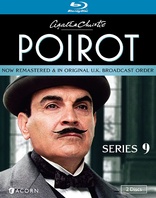Poirot: Series 9 Blu-ray Movie
HomePoirot: Series 9 Blu-ray Movie 
Acorn Media | 2003-2004 | 392 min | Not rated | Oct 29, 2013Movie rating
8.3 | / 10 |
Blu-ray rating
| Users | 0.0 | |
| Reviewer | 4.0 | |
| Overall | 4.0 |
Overview
Poirot: Series 9 (2003-2004)
Five Little Pigs / Sad Cypress / Death on the Nile / The Hollow
Starring: David Suchet, Hugh Fraser (I), Philip Jackson (II), Pauline Moran, David YellandDirector: Edward Bennett (I), Andrew Grieve, Renny Rye, Brian Farnham
| Period | Uncertain |
| Mystery | Uncertain |
| Crime | Uncertain |
| Drama | Uncertain |
| Thriller | Uncertain |
Specifications
Video
Video codec: MPEG-4 AVC
Video resolution: 1080p
Aspect ratio: 1.78:1
Original aspect ratio: 1.78:1, 1.33:1
Audio
English: DTS-HD Master Audio 2.0
Subtitles
English SDH
Discs
50GB Blu-ray Disc
Two-disc set (2 BDs)
Packaging
Slipcover in original pressing
Playback
Region A (locked)
Review
Rating summary
| Movie | 4.5 | |
| Video | 4.0 | |
| Audio | 3.5 | |
| Extras | 0.0 | |
| Overall | 4.0 |
Poirot: Series 9 Blu-ray Movie Review
Monsieur P. Returns in HD
Reviewed by Michael Reuben November 22, 2013Almost two and a half years passed between the completion of Series 8 of Poirot and the appearance of the first episode of Series 9. (The final episode of Series 8 did not air in the U.K. until over a year after it was filmed.) In that time, the format continued to be revamped. New writers, producers and directors came aboard, and a jazzier style of shooting and editing evolved to suit the times. Long-time viewers weren't always thrilled, but there's no disputing that the efforts of the new creative team reinvigorated a series that, fourteen years into its run, had begun to fall into familiar and often predictable rhythms. After the disappointment of the video quality displayed on the Blu-ray episodes comprising Series 7 & 8, the episodes in Series 9 represent a welcome return to the high quality first established by Acorn Media with their releases of Series 1 through 6 of Poirot. When I first reviewed Series 9, I had been told that it was shot in original HD, but since then I have received contradictory information. (IMDb, as usual with British TV, is unhelpful, unreliable and/or inaccurate.) The appearance of the footage itself is consistent with either HD capture or filmed footage heavily processed in the digital domain in the manner applied by restoration facility JCA to restore the episodes in Series 1 through 6. Lacking a definitive answer, I will simply note that the visual style of Poirot in Series 9 was updated with the rest of the series, abandoning the Art Deco style that had dominated the early days and settling for a more generic period look. Whatever the method of photography, the visual difference between Series 9 and its immediate predecessor is literally night and day.
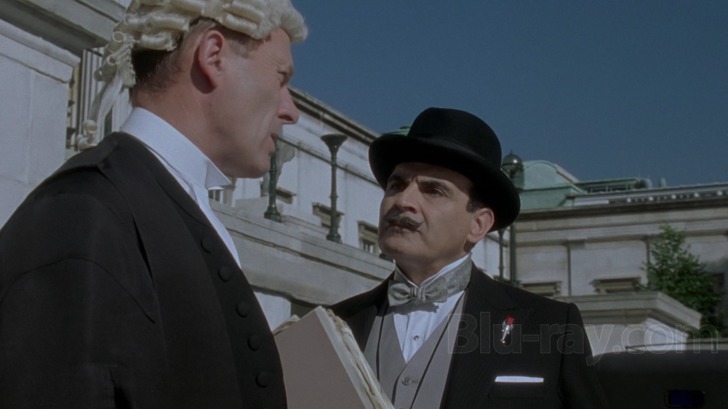
Five Little Pigs (disc 1) (first broadcast: Dec. 14, 2003, U.K.) Fourteen years after the murder of a painter named Amyas Crale (Aidan Gillen), his daughter, Lucy (Aimee Mullins), retains Hercule Poirot to prove that her mother, Caroline Crale (Rachael Stirling), was falsely executed for the crime. Lucy's faith in her mother's innocence is based on a letter that Caroline Crale wrote to her from prison shortly before she was hanged. Poirot accepts the engagement, but cautions young Lucy that he can offer her only the truth, whatever it may be. Privately, he seems to relish the prospect of investigating a murder solely through the recollections of witnesses. There are five such interviewees; hence the title of the episode (taken directly from Agatha Christie's novel). Amyas Crale was poisoned with hemlock during a weekend stay at the Crale country home, where he was painting a portrait of his latest model, Elsa Greer (Julie Cox). As had long been his habit, Crale was romantically involved with his model, and the prosecution argued that Caroline Crale killed her husband out of jealousy. Elsa Greer, now known as Lady Dittisham, certainly supports that theory, recounting how Amyas Crale planned to leave his wife and marry her instead. Crale's best friend, Philip Blake (Toby Stephens), is also no fan of Caroline Crale, whom he describes as cold, cruel and calculating. Philip's introverted brother, Meredith (Marc Warren), an amateur herbalist from whose lab the hemlock extract was stolen, also points the finger at Caroline, at least to the extent of confirming she had access to the hemlock extract and the opportunity to steal it. Caroline Crale's younger sister, Angela Warren (Sophie Winkelman), is blind in one eye as a result of a childhood quarrel with Caroline, providing proof of her temper. Both Angela and her governess, Miss Williams (Gemma Jones), provide damaging circumstantial evidence indicating that Caroline poisoned her husband with hemlock by adding it to a bottle of beer that she brought to him while he painted. After consulting with the barrister who argued Caroline's case (Patrick Malahide), Poirot is struck by the inconsistency between her conduct at the trial, where she did not protest her innocence, and the letter asserting her innocence that she sent to her daughter, prompting Lucy to engage Poirot. As his famous "little gray cells" sort through the accounts, tiny inconsistencies reveal an entirely different narrative than the one related in court. Just as he promised, Poirot eventually presents Lucy, and all five witnesses, with the truth. Sad Cypress (disc 1) (first broadcast: Dec. 26, 2003, U.K.) Sad Cypress opens in a courtroom, where Elinor Carlisle (Elisabeth Dermot Walsh) sits in the dock, accused of a double murder. Poirot observes from the gallery. Much of the story is revealed in flashbacks. Elinor was happily engaged to Roddy Winter (Rupert Penry-Jones) but received an anonymous letter warning that her inheritance from her wealthy aunt, Laura Welman (Diana Quick), was threatened from an unknown source. Elinor and Roddy went to visit Mrs. Welman in the country, where they found that she had become attached to one Mary Gerrard (Kelly Reilly), the lodgekeeper's daughter, recently returned from an education in Europe and admired by everyone in the household—everyone, that is, except Elinor, who was devastated one evening when she discovered her fiancé and Mary in each other's arms. Mrs. Welman was bedridden following a stroke, attended constantly by Nurse Hopkins (Phyllis Logan) and Nurse O'Brien (Marion O'Dwyer). Elinor showed the letter she received to Mrs. Welman's physician, Dr. Peter Lord (Paul McGann), who was concerned enough to call in his old friend, Hercule Poirot. Something about the letter troubled Poirot. It seemed more than just a piece of malicious gossip. Shortly after announcing her intention to make a new will naming Mary as a beneficiary, Mrs. Wellman suffered another stroke, this time a fatal one. After Mrs. Wellman's funeral, her solicitor revealed that she had no will; thus, as her nearest living relative, Elinor inherited her entire fortune. Mindful of her late aunt's wishes, however, Elinor agreed to settle a generous sum on Mary. But Mary had little time to enjoy her good fortune. Upon consuming sandwiches prepared by Elinor for tea, she suddenly collapsed and died from what was later determined to be morphine poisoning. A vial of morphine had previously gone missing from the nurses' supplies. Exhumation and autopsy of Laura Welman's body revealed that she, too, was poisoned with morphine. Elinor Carlisle was charged with murdering her aunt for money and murdering Mary out of jealousy. As usual, Poirot's analysis turns on details that others ignore: fine points of English cuisine (what about those sandwiches?); specifics of English horticulture (a scratch by rose thorns provides a clue); and, of course, issues of bloodlines and inheritance, which were always a fertile source of motive for Agatha Christie. Fans of Breaking Bad may find this particular episode of interest, because it contains a plot element which Bad's writers borrowed to great effect, after giving it their own unique spin. I cannot say more without spoilers, but anyone familiar with Vince Gilligan's groundbreaking show will know what I mean when they see it. Death on the Nile (disc 2) (first broadcast: Apr. 12, 2004, U.K.) Death on the Nile was the first of the six works of Agatha Christie to be adapted (in 1978) for Peter Ustinov's incarnation of Hercule Poirot, and it remains a favorite among Christie's Poirot novels because of the large and colorful cast and the plethora of subplots. The adaptation for this series, by Kevin Elyot (who also scripted Five Little Pigs and the recently aired Curtain: Poirot's Last Case), remains generally faithful to the novel, with a few changes and some minor trimming. Simon Doyle (JJ Feild) and Jacqueline De Bellefort (Emma Malin) are engaged but penniless. Unfortunately for Jacqueline, she makes the mistake of introducing Simon to her wealthy friend Linnet Ridgeway (Emily Blunt). A few months later, Linnet and Simon are married and honeymooning in Egypt, where they cross paths with a vacationing Poirot. Jacqueline is there as well. She has been stalking the newlyweds across two continents, and when Linnet sees Poirot, she approaches him for assistance. He agrees to speak to Jacqueline, who, without hesitation, professes murderous intentions toward Linnet. Hoping to evade Jacqueline, Linnet and Simon slip away on board a ship called the Karnak, but Jacqueline cannot be evaded so easily. The Karnak is host to an assortment of eccentrics, including the very demanding Miss Van Schuyler (Judy Parfitt) and her put-upon younger cousin, Cornelia Robson (Daisy Donovan); a Mrs. Allerton (Barbary Flynn) and her son, Tim (Daniel Lapaine), who seem unusually close; Andrew Pennington (David Soul), the American trustee of the wealth belonging to Linnet Doyle (formerly Ridgeway); and the uninhibited Salome Otterbourne (Frances de la Tour) and her perpetually embarrassed daughter, Rosalie (Zoe Telford). Linnet has brought her French maid, Louise (Félicité Du Jeu), and a physician, Dr. Bessner (Steve Pemberton), is also aboard. His services turn out to be much in demand. With so much setup and so many intrigues, it would be a disservice to first-time viewers to identify the murder victim, because there are several obvious candidates. Indeed, by the time Poirot works out the solution, there are also several victims. As in Evil Under the Sun in Series 8, the great detective is presented with a situation in which everyone seems to have a solid alibi—which means, of course, that the crime has been carefully planned in advance. Assisting Poirot in gathering clues is an old acquaintance, Colonel Race (James Fox), who is part of the colonial authority and seems to have a specific interest in one of the ship's passengers. The Hollow (disc 2) (first broadcast: Apr. 26, 2004, U.K.) Hercule Poirot's sojourns in the English countryside never seem to provide him with any rest. When Poirot takes a cottage, he has the bad fortune (or maybe he would consider it lucky) to be neighbor to "The Hollow", the home of Sir Henry and Lucy Angkatell (Edward Hardwicke and the deliciously goofy Sarah Miles). They are having guests for the weekend, and Lucy Angkatell thinks it would be great fun to invite the famous Belgian detective to join them for dinner. Like every collection of guests in a Christie story, this one is a recipe for trouble. Dr. John Christow (Jonathan Cake) is a distinguished physician and medical researcher—and also a philandering cad of the first order. He arrives with his flighty wife, Gerda (Claire Price), knowing full well that the Angkatells have also invited his mistress, a sculptor named Henrietta Savernake (Megan Dodds). Henrietta, in turn, is the object of a long-term passion by Lucy Angkatell's cousin, Edward (Jamie de Courcey), but Henrietta doesn't return Edward's feelings. If only John Christow were out of the way, he tells her, with the ominous tone that could only occur in a murder mystery. Also among the guests is Midge Hardcastle, who has long been in love with Edward, though he only has eyes for Henrietta. And late in the evening, after Poirot has dined with the Angkatells, another character enters the drama in the person of Veronica Cray (Lysette Anthony), an English-born actress newly returned from a career in Hollywood, who is renting another cottage in the neighborhood. The pretext for Veronica's visit is to borrow some matches, but it turns out that she and Dr. Christow knew each other before Veronica left for Hollywood. Indeed, they were lovers, and Veronica makes it clear she'd like to rekindle the flame. Was ever a doctor so much in demand? When Dr. Christow is murdered under circumstances that first point directly to, and then increasingly away from, his wife as the obvious culprit, Poirot is struck by the degree of artifice that has obviously been arranged for the benefit of both himself and the local police, represented by Inspector Grange (Tom Georgeson). Who has gone to such lengths, and what are they concealing? During the course of his investigation, someone remarks to Poirot that he has made detective work an art, but the Belgian sleuth disagrees. In Poirot's world, finding the truth is a matter of logic and observation, not art. Justice, however, is a different matter entirely.
Poirot: Series 9 Blu-ray Movie, Video Quality 
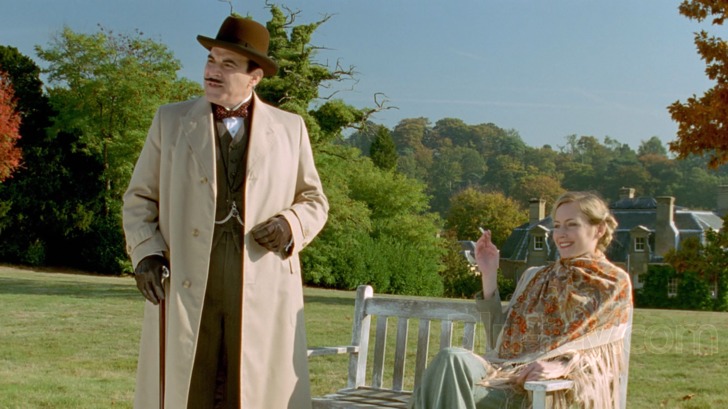
The cinematographers for these episodes of Poirot were James Aspinall (The Hollow) and Martin Fuhrer (the remaining three), both of whom are regular fixtures at the high end of British TV. With one minor issue, Acorn Media's 1080p, AVC-encoded Blu-rays are everything one could hope for: clear, sharp and detailed, with solid blacks, varied but not oversaturated colors and contrast that illuminates without overwhelming detail. The one negative is the occasional appearance of light video noise in portions of the frame, typically where there has been less illumination on the set so that the image has presumably been "pushed" in post-production. It's a minor flaw and fleeting when it occurs. The average bitrate of just over 20 Mbps is reasonable for a production that does not involve major action sequences and has no visible film grain. (There is a digital texturing that some might consider grain, but close examination reveals it to be digital rather than analog.) Other than the video noise noted above, no artifacts were observed. Still, given the significant unused space on these two BD-50s, it hardly seems necessary for Acorn to compress these episodes so tightly.
Poirot: Series 9 Blu-ray Movie, Audio Quality 
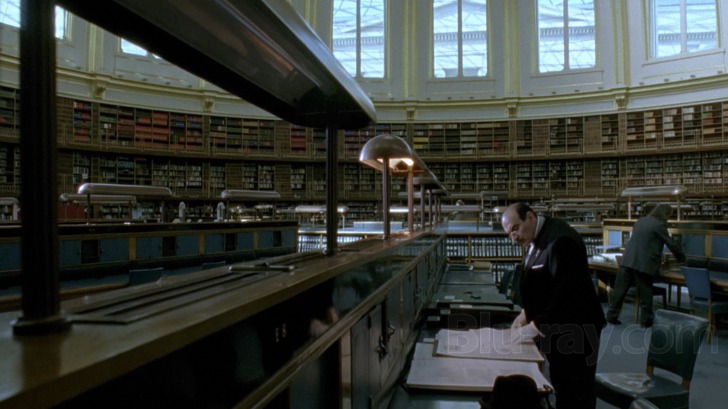
Having finally embraced lossless DTS-HD MA 2.0 for Poirot, Acorn Media appears determined to keep it. The stereo sound mixes for these four episodes are consistent with prior episodes of Poirot, with the difference that Christopher Gunning has adopted a livelier and more contemporary style in his scoring, with music occupying a larger presence in the sound mix. Dialogue remains clear, and sound effects are functional and precise.
Poirot: Series 9 Blu-ray Movie, Special Features and Extras 
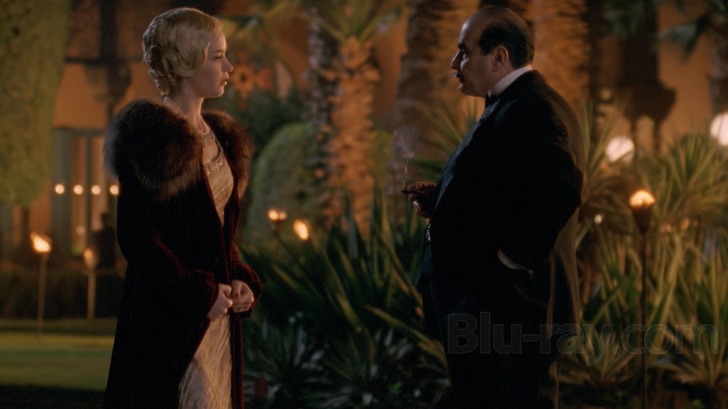
No extras are included. At startup, disc 1 plays the usual trailer for Acorn Media, plus trailers for Miss Fisher's Murder Mysteries and Jack Taylor.
Poirot: Series 9 Blu-ray Movie, Overall Score and Recommendation 
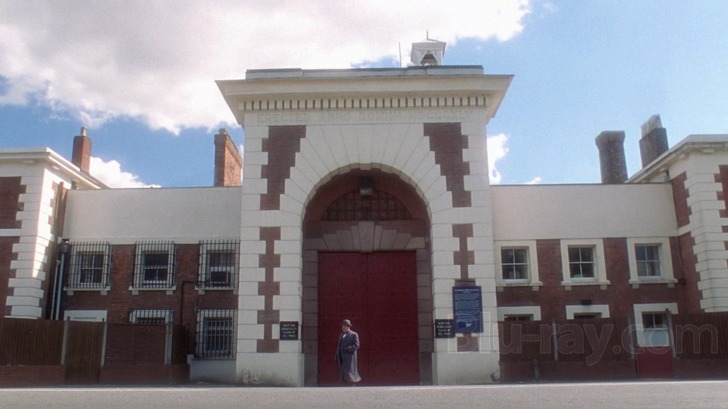
As of this writing, Poirot has completed its long run in the United Kingdom, and U.S. fans eagerly await the debut of the final episodes on PBS. Acorn will conclude 2013 with all but Series 11 and 13 released on Blu-ray (the episodes from Series 12 have been released separately). Fans can rejoice that, with the appearance of Series 9, Acorn's releases have returned to the level of quality on which its fans have come to rely. Highly recommended.
Other editions
Poirot: Other Seasons

Poirot: Series 1
1989

Poirot: Series 2
1990

Poirot: Series 3
1991

Poirot: Series 4
1992

Poirot: Series 5
1993

Poirot: Series 6
1995-1996

Poirot: Series 7 & 8
2000-2001

Agatha Christie's Death on the Nile
2004

Poirot: Series 10
2006

Poirot: Series 11
2008-2009

Poirot: The Movie Collection - Set 6
2009-2010

Poirot: Murder on the Orient Express
2010

Poirot: Series 12
2010-2011

Poirot: Series 13
2013
Similar titles
Similar titles you might also like
(Still not reliable for this title)

The Mirror Crack'd
1980

State of Play
2009

Murdoch Mysteries: Season 18
The Artful Detective
2024-2025

Zodiac 4K
Theatrical 4K | Director's Cut BD only
2007

Foyle's War: Set 8
2014

The Night of the Generals
Limited Edition to 3000 - SOLD OUT
1967

Murder on the Orient Express 4K
50th Anniversary Edition
1974

Miss Marple: Volume 1
The Murder at the Vicarage / The Body in the Library / The Moving Finger / A Murder is Announced
1984-1986

The Raven
2012

Murder on the Orient Express
2017

Twisted
2004

The Black Dahlia
2006

Evil Under the Sun
1982

Gosford Park
Arrow Academy
2001

Crooked House
2017

The Girl with the Dragon Tattoo
2011

The Bone Collector 4K
1999

Murder by Decree 4K
1979

Taboo: Season One
2017

L.A. Confidential
1997
